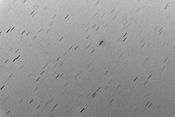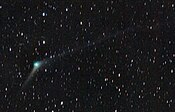C/2013 US10 (Catalina)
 C/2013 US10 as seen on 9 Dec 2015. To the upper left is the ion gas tail and to the lower right is the dust tail. | |
| Discovery | |
|---|---|
| Discovered by | Catalina Sky Survey (703)[1][2] |
| Discovery date | 31 October 2013 |
| Orbital characteristics A | |
| Epoch | 4 December 2015[3] |
| Orbit type | Oort cloud |
| Aphelion | ~38000 AU (inbound)[4] |
| Perihelion | 0.8229 AU (q)[3] |
| Eccentricity | 1.0003[3] |
| Orbital period | several million years inbound (Barycentric solution for epoch 1950)[4] Ejection trajectory outbound (Barycentric solution for epoch 2050)[4] |
| Inclination | 148.87°[3] |
| Jupiter MOID | 1.13 AU |
| Last perihelion | 15 November 2015[3] |
C/2013 US10 (Catalina) is an Oort cloud comet discovered on 31 October 2013 by the Catalina Sky Survey at an apparent magnitude of 19 using a 0.68-meter (27 in) Schmidt–Cassegrain telescope.[1] As of September 2015 the comet is around apparent magnitude 6.[5]
Overview[]
When discovered on 31 October 2013 observations from another object from 12 September 2013 were used in the preliminary orbit determination giving an incorrect solution that suggested an orbital period of only 6 years.[1] But by 6 November 2013 a longer observation arc from 14 August until 4 November made it apparent that the first solution had the wrong object from 12 September.[2]
By early May 2015 the comet was around apparent magnitude 12 and had an elongation of 60 degrees from the Sun as it moved further into the southern hemisphere.[6] The comet came to solar conjunction on 6 November 2015 when the comet was around magnitude 6.[5] The comet came to perihelion (closest approach to the Sun) on 15 November 2015 at a distance of 0.82 AU from the Sun.[3] At perihelion, it had a velocity of 46.4 km/s (104,000 mph) with respect to the Sun which is slightly greater than the Sun's escape velocity at that distance. It crossed the celestial equator on 17 December 2015 becoming a northern hemisphere object. On 17 January 2016 the comet will pass 0.72 AU (108,000,000 km; 67,000,000 mi) from Earth and should be around magnitude 6[5] while located in the constellation of Ursa Major.
C/2013 US10 is dynamically new. It came from the Oort cloud with a loosely bound chaotic orbit that was easily perturbed by galactic tides and passing stars. Before entering the planetary region (epoch 1950), C/2013 US10 had an orbital period of several million years.[4] After leaving the planetary region (epoch 2050), it will be on an ejection trajectory.[4]
Gallery[]

Comet C/2013 US10 (Warsaw, Poland; January 10, 2016, 02:51 UT+1)

C/2013 US10 imaged on December 6, 2015

C/2013 US10 imaged on December 6, 2015 (black and white)
References[]
- ^ Jump up to: a b c "MPEC 2013-V05 : 2013 US10". IAU Minor Planet Center. 2 November 2013. Retrieved 15 September 2014. (K13U10S)
- ^ Jump up to: a b "MPEC 2013-V31 : COMET C/2013 US10 (CATALINA)". IAU Minor Planet Center. 6 November 2013. Retrieved 15 September 2014. (CK13U10S)
- ^ Jump up to: a b c d e f "MPEC 2014-R69 : Observations and Orbits of Comets". IAU Minor Planet Center. 7 September 2014. Retrieved 15 September 2014.
- ^ Jump up to: a b c d e Horizons output. "Barycentric Osculating Orbital Elements for Comet C/2013 US10 (Catalina)". Solution using the Solar System Barycenter. Ephemeris Type:Elements and Center:@0 (To be outside planetary region, inbound epoch 1950 and outbound epoch 2050)
- ^ Jump up to: a b c Seiichi Yoshida (13 September 2014). "C/2013 US10 ( Catalina )". Seiichi Yoshida's Comet Catalog. Retrieved 15 September 2013.
- ^ "Elements and Ephemeris for C/2013 US10 (Catalina)". IAU Minor Planet Center. Archived from the original on 17 May 2014. Retrieved 15 September 2014.
External links[]
| Wikimedia Commons has media related to C/2013 US10 (Catalina). |
- Cometary object articles
- Astronomical objects discovered in 2013
- Comets in 2015
- Oort cloud







